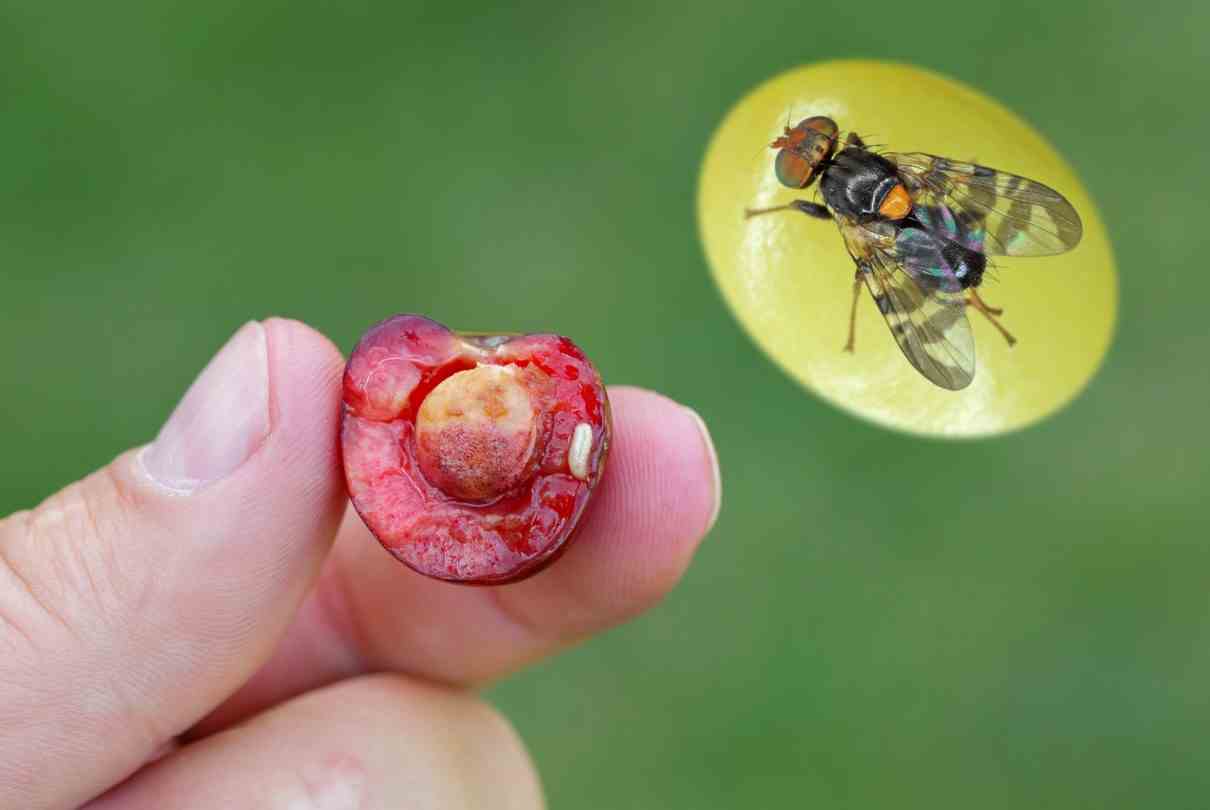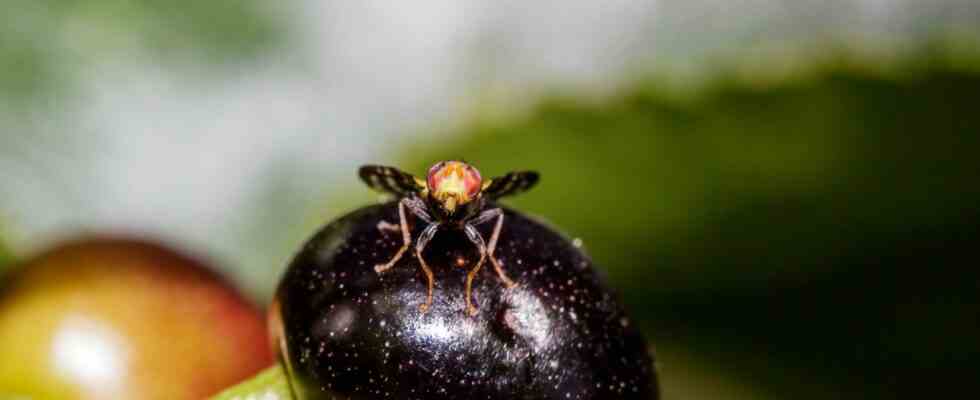Cherry fly species
Rhagoletis cerasi
As an adult, this little fly barely measures 5mm long. It is recognizable by the yellow spot which stands out against its black body. On its transparent wings are drawn longitudinal stripes of black or dark blue color. For its part, the larva looks like a white maggot which can reach 6 mm in length when fully developed.
Drosophila suzukii
An Asian midge that arrived in France in the 2010s, cherry fruit fly, Drosophila suzukiiis smaller than the Rhagoletis cerasisince it has a size of approximately 3mm, females being larger than males. The latter are characterized by two sets of bristles also called “combs” on each of their anterior tarsi.
These midges can be differentiated from those of the preceding species by their black spot on each wing, instead of bands. The female has a ovipositor, that is, an egg-laying organ, which is large and toothed. It differs from the male by the absence of bristles on the tarsi. Whitish in color with two black mouth hooks, the larvae are also smaller since they are a maximum of 3.5 mm long. In the extension of the abdomen, one can notice sorts of growth which are the posterior stigmata.
Their life cycle
In both species, the life cycle itself is similar, that is to say that a female lays eggs which will give birth to larvae which will then follow the different stages of their metamorphosis into flies. But as you will see, in Drosophila suzukii, everything happens in a hurry. And this is not the only difference that in terms of the damage caused, this fly is much more dangerous.
| Life cycle | Rhagoletis cerasi | Drosophila suzukii |
| Laying period | One to two weeks after fledging: to do this, using their auger, they introduce their eggs, at the rate of 1 per fruit, under the skin of the cherry in formation. | The females have often been fertilized before the winter period, which they spend sheltered in hedges, thickets, etc. With their ovipositor, they incise the skin of fruits to lay up to 3 eggs per fruit. |
| Number of eggs | A single female can thus lay eggs in 50 to 80 fruits. | A single female can lay between 7 and 16 eggs per day. During her life, although it is short, a female lays about 380 eggs. |
| Egg hatching | Between 6 to 12 days later, the eggs will hatch | For egg hatching 1-3 days are enough |
| From larva to fly | The larvae will develop for 3 to 4 weeks in the pulp of the cherry in which they were born, and, of course, feed on it. Each larva develops exclusively around the nucleus and is less mobile than that of Drosophila suzukii. At the end of their growth, they drop to the ground to bury themselves a few centimeters from the surface of the earth. They will thus spend 1 to 3 winters underground, during which time they will follow the different stages of development from pupation to metamorphosis into flies. | In just 3 to 13 days, the larvae will feed on the fruit they are in and go through 3 different stages of their development. Then, for 3 to 15 days, pupation will take place, which can take place inside or outside the fruit, but not underground. Once adults, the larvae become flies tear the pupa to free themselves. They then have a lifespan of 3 to 9 weeks, but 1 to 3 days after emerging, they are already able to mate and lay a new generation of eggs. |
| In winter | The larvae live and develop underground. | Flies can survive in a hedge while waiting for warmer temperatures. |
| Cycle time | There is a life cycle every 2 or 3 years. 1 single generation per year. | A complete cycle lasts from 13 to 28 days and 13 generations of larvae can follow one another from spring to autumn. |
| Affected fruit | Only cherries are concerned | It can lay indifferently in cherries, strawberries, peaches, etc. |
Damage caused by the cherry fly
Generally speaking, it is not always obvious to immediately see that your cherry tree or trees are victims of a cherry fly attack. It is therefore necessary to regularly monitor your trees. Here is the damage you can see on your fruits:
- Insofar as the larvae will feed on the pulp of the cherriesthey will damage them and cause them to rot. With Rhagoletis cerasi, the varieties most at risk are mid-season and late varieties. Varieties with earlier fruiting will be less affected. With Drosophila suzukii, many other fruits in your orchard may be affected, all soft ones, in fact.
- Insofar as these two species of fly pierce the epidermis of the fruit to lay their eggs, this puncture point allows fungi and bacteria to enter the fruit which will then rot and become unfit for human consumption. But even worse, nearby healthy fruit can be contaminated.
Prevent the appearance of the cherry fly
Here are some solutions to avoid cherry fly attacks:
- Choose early varietiessuch as bigarreau Napoleon, burlat, etc., whose fruit matures before the flies are too active.
- In winter, hoe the soil to expose the Rhagoletis cerasi larvae to the cold and to their predators, thereby reducing the population of cherry fly in the future.
- You can also cover the groundto prevent the larvae from burrowing into the ground.
- Be careful not to leave ripe fruit in the tree or rot on the ground. When the fruits are ripe and not wormy, you can eat them, otherwise throw them, but not in your composter.

Fight against the cherry fly
Precautions
There are different treatments to control the cherry fly, like the insecticides. However, turn to these only as a last resort and use them with caution. It is better for human, animal and environmental health to opt, in priority, for alternative solutions such as those described below.
The traps
They aim to attract flies to kill them before they go to lay eggs in the cherries. Different types of traps are sold commercially:
- the glue trap which you can also make by yourself. This solution is quite effective and more environmentally friendly than other solutions. Yellow in color and covered with glue on both trap sides, these traps attract flies and hold them captive. They will have to be installed from the month of April at the rate of several per tree. The number varies depending on the size of it.
- The pheromone trap which is a plastic container containing pheromones to attract insects and a liquid in which they drown.
- You can also make traps out of plastic bottles, as for wasps. Paint them yellow or red. To attract gnats, you can put inside pheromones purchased in a sachet on the market or a mixture of water, cider vinegar, red wine, in equal quantities, and a drop of dishwashing liquid.
Natural insecticides
There are insecticides based on pyrethrum, but its effectiveness is limited. The use of this type of insecticide is questionable, since it can kill other insects and harm the ecological balance of the garden. You can also find a treatment based on mushrooms, but rather intended for professionals.

